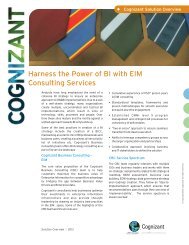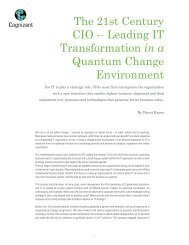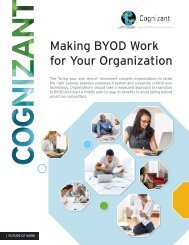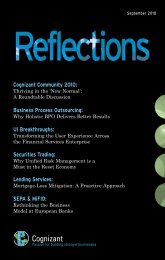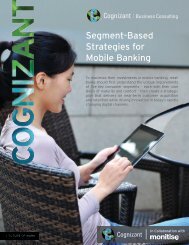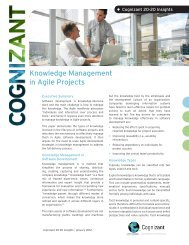A Holistic Approach to Business Process Management ... - Cognizant
A Holistic Approach to Business Process Management ... - Cognizant
A Holistic Approach to Business Process Management ... - Cognizant
Create successful ePaper yourself
Turn your PDF publications into a flip-book with our unique Google optimized e-Paper software.
• <strong>Cognizant</strong> 20-20 InsightsA <strong>Holistic</strong> <strong>Approach</strong> <strong>to</strong> <strong>Business</strong><strong>Process</strong> <strong>Management</strong>: This Way <strong>to</strong>Better Cus<strong>to</strong>mer ExperienceExecutive Summary<strong>Business</strong> process management (BPM) isincreasingly helping companies reduce costs,improve efficiency, nurture innovation and getcloser <strong>to</strong> cus<strong>to</strong>mers. As the name suggests,BPM is the practice of optimizing and refiningprocesses from end-<strong>to</strong>-end <strong>to</strong> promoteefficiency and increase cus<strong>to</strong>mer value. Companiesof different sizes from the full range ofvertical industries can use thoughtfully appliedBPM <strong>to</strong> further their business goals.In fact, leading analyst firms identify BPM asamong the <strong>to</strong>p technology trends. According <strong>to</strong> aFebruary 8, 2011 blog post by Forrester ResearchVice President and Research Direc<strong>to</strong>r ConnieMoore entitled, “Tackle The Most Common BPMChallenges,” “BPM projects typically deliver30% <strong>to</strong> 50% productivity gains for processesinvolving back-office and clerical staff, and theytypically deliver 15% <strong>to</strong> 30% productivity gainsfor processes involving knowledge workers.”Organizations and business units are now looking<strong>to</strong> BPM <strong>to</strong> enhance business processes <strong>to</strong> providemaximum cus<strong>to</strong>mer value.Executed well, BPM carries a number of businessbenefits:• Operational cost savings: Au<strong>to</strong>mating manualprocesses eliminates waste, improves efficienciesand increases accuracy. Au<strong>to</strong>mated processesrequire the involvement of fewer peoplein the organization. Training costs go down,especially for CRM systems. Companies thatare successful in their BPM approach typicallysee a significant overall cost improvement.• Improved sales opportunity: Optimizingend-<strong>to</strong>-end sales processes boosts the valueprovided <strong>to</strong> prospects and cus<strong>to</strong>mers.• Greater cus<strong>to</strong>mer satisfaction, leading <strong>to</strong>higher cus<strong>to</strong>mer retention: Fundamentally,BPM is about improving business processeswith the aim of providing a better cus<strong>to</strong>merexperience. Moving the organization <strong>to</strong>wardcus<strong>to</strong>mer centricity boosts cus<strong>to</strong>mer satisfaction,which means cus<strong>to</strong>mers will be less likely<strong>to</strong> defect <strong>to</strong> competi<strong>to</strong>rs.This white paper will help you understand how<strong>to</strong> holistically deploy BPM. It will demonstratea proven way <strong>to</strong> assess where BPM fits in yourenvironment, how some companies are leveragingBPM <strong>to</strong> streamline and au<strong>to</strong>mate key businessprocesses, and new and emerging technologiesthat effect how BPM services are delivered andconsumed.BPM in Your OrganizationMost businesses and other organizations areorganized around disconnected business functions,cognizant 20-20 insights | march 2012
Getting all youremployees <strong>to</strong>think about thebigger picture,from the originof the businessprocess <strong>to</strong> whereit <strong>to</strong>uches theend cus<strong>to</strong>mer, is amajor challengein BPM.such as sales, marketing, production, cus<strong>to</strong>merservice, research and development, operations,finance, HR and the like. This siloed, or functionbased,organizational structure originated at thedawn of the Industrial Age when it was the mostefficient labor arrangement in a non-au<strong>to</strong>matedworld. Today, however, organizationsare largely au<strong>to</strong>mated.This means that any businessprocess delivering value <strong>to</strong>cus<strong>to</strong>mers tends <strong>to</strong> crossfunctional boundaries. Unfortunately,employees rarely lookbeyond their functional silos <strong>to</strong>see how work that <strong>to</strong>uches thecus<strong>to</strong>mer is conducted withincorresponding functions withinthe organization. This is problematicas high-value businessprocesses naturally reside witha larger, cross-functional wayof working. Getting all youremployees <strong>to</strong> think about the bigger picture, fromthe origin of the business process <strong>to</strong> where it<strong>to</strong>uches the end cus<strong>to</strong>mer, is a major challengein BPM.A necessary starting point for effective BPM is <strong>to</strong>move the organization from functional thinking(with its associated organizational chart) <strong>to</strong> aprocess mindset (with a process-driven hierarchy).Often, this requires peelingWe find thereis an art as wellas a science <strong>to</strong>selecting the firstbusiness processes<strong>to</strong> optimizevia BPM.Corners<strong>to</strong>nes of BPMdecades of firmly entrenched,out-of-date work patterns andpractices from executives whocannot imagine any otherway of getting work done.The transition <strong>to</strong> cus<strong>to</strong>mercentricity that underlieseffective BPM can shake thebusiness <strong>to</strong> its foundation.In our experience, many companies do notapproach BPM holistically. The temptation is <strong>to</strong>focus exclusively on process au<strong>to</strong>mation andconsider the BPM program successful with eachincremental bit of au<strong>to</strong>mation achieved. Unfortunately,this limited approach can result in implementationof many different point BPM solutionsthat do not generate business benefits. That isbecause no one s<strong>to</strong>pped <strong>to</strong> define the businessbenefits before implementing the <strong>to</strong>ol. Companiesoften architect themselves in<strong>to</strong> a corner becausethey did not take a <strong>to</strong>p-down approach <strong>to</strong> BPM.This is a multi-functional effort that must start bytaking a higher view than just what one <strong>to</strong>ol canachieve. In our view, there are three corners<strong>to</strong>nesof BPM:1. <strong>Process</strong> Engineering: When companies launcha BPM program, the purpose is <strong>to</strong> achievebusiness goals, not IT goals. In fact, anyattempt <strong>to</strong> cost-justify a BPM project must becharacterized at the most basic levels in termsof revenue gained or profitability boosted,or the effort will not garner the requisitelevel of executive support. The first step of atransformational BPM program, therefore, is<strong>to</strong> identify the business goals <strong>to</strong> be achieved.In our experience, many companies startwith the goal of improving overall cus<strong>to</strong>merservice. The next step is <strong>to</strong> identify the metricsand key performance indica<strong>to</strong>rs (KPIs) thatrelate <strong>to</strong> the business goal. Here, applicablemetrics would include cus<strong>to</strong>mer satisfactionscore, percentage of cus<strong>to</strong>mer service eventshandled through self-service channels andfirst-call resolution.With the metrics clearly categorized, the nextstep is <strong>to</strong> identify processes that drive thesemetrics. This requires identifying processesthat add value for the cus<strong>to</strong>mer. We find thereis an art as well as a science <strong>to</strong> selecting thefirst business processes <strong>to</strong> optimize via BPM.You will want <strong>to</strong> look for a manual process thathas a high profile within your organization.At the same time, this process must be able<strong>to</strong> yield easily demonstrable business benefitsthat can be achieved fairly quickly. We workedwith an insurance provider, for example, thatbegan with claims processing. The next stepis <strong>to</strong> study the inefficiencies in the existingbusiness process (the “as-is” process). Then,you prepare a recommended reengineeringof the business process (the “<strong>to</strong>-be” process).The end product of this stage will be a set ofprocess diagrams and process flows.2. <strong>Process</strong> Au<strong>to</strong>mation: In the second phase,you convert these process diagrams in<strong>to</strong> code.This is where your BPM solution comes in<strong>to</strong>play. Your <strong>to</strong>ol will au<strong>to</strong>mate the previouslymanual process. For example, take the scenarioof a cus<strong>to</strong>mer calling his credit card company<strong>to</strong> dispute a transaction. The call center agenttakes the details of the dispute and then,depending on the transaction amount, theagent will be au<strong>to</strong>matically authorized <strong>to</strong> givethe caller a credit or <strong>to</strong> investigate the mattercognizant 20-20 insights 2
In our experience,most companiesfail <strong>to</strong> do anadequate jobof measuringbusiness benefitsattained.One effectiveapproach is <strong>to</strong>“test-drive” cloudBPM, or create aproof of concept<strong>to</strong> determine itsviability in yourorganization.further. Without au<strong>to</strong>mation, the agent in thecall center would have <strong>to</strong> manually go throughthe rules with the cus<strong>to</strong>mer onthe phone and decide whether<strong>to</strong> issue the credit, burdeningthe cus<strong>to</strong>mer by making him wai<strong>to</strong>n hold. Au<strong>to</strong>mating the processmeans the decision-making onthe rules can be made au<strong>to</strong>matically.Under the au<strong>to</strong>matedprocess, the embedded businessrules could dictate that if thedisputed amount is under $100and the cus<strong>to</strong>mer is a platinum card holder, thecredit should be granted immediately.3. <strong>Process</strong> Optimization: At the end of theprocess au<strong>to</strong>mation phase, the company willhave newly au<strong>to</strong>mated processes. But s<strong>to</strong>ppingthere is not advisable — the critical next stepis <strong>to</strong> measure if the au<strong>to</strong>mated processeshave achieved the expected benefits. Youhave <strong>to</strong> compare the au<strong>to</strong>mated processesagainst your target metrics. If there is agap between the two, you will have <strong>to</strong> go back<strong>to</strong> your process engineering phase (Step 1)and do more work before proceeding again<strong>to</strong> process au<strong>to</strong>mation (Step 2), finishing withStep 3 (measurement). In our experience,most companies fail <strong>to</strong> do an adequate job ofmeasuring business benefits attained. Theyfall short of determining whether or not theprogram was successful.Case Study: BPM in the HealthInsurance IndustryIn 2009, we were asked <strong>to</strong> implement a call centerstrategy for a major health insurance provider.The engagement started with a thorough examinationof current call center processes, theclient’s overall goals for cus<strong>to</strong>merservice, what it wanted <strong>to</strong> achievefrom a business standpoint andhow <strong>to</strong> map <strong>to</strong> current processes.We reengineered the processes<strong>to</strong> eliminate inefficiencies andincrease cus<strong>to</strong>mer satisfaction.Key drivers for what becameknown as the cus<strong>to</strong>mer servicedesk<strong>to</strong>p solution included a move<strong>to</strong> a future-ready platform and aretail-focused business organization.We reviewed the existing cus<strong>to</strong>mer serviceplatform and developed a business solutionand enabling technical solution. Our approachensured budget and scheduling compliance. Werecommended that development of the cus<strong>to</strong>merservice platform leverage offshore resources <strong>to</strong>reduce costs and accelerate the timeframe. Weestimated this BPM project would have an activetimeframe of about three years and a paybackperiod of roughly six years. In addition, the insurerwould see a reduction in training time by 30%,an increase in efficiency and an improvement infirst call resolution by 25%. In addition, call centeragents would have greater visibility in<strong>to</strong> cus<strong>to</strong>merdata, resulting in a more consistent cus<strong>to</strong>merexperience across channels.We planned a multi-year, phased approach forthe health insurer that would provide iterativebusiness capability delivery with subsequentphases building on initial work. We estimated wewould save the insurer more than $10 million overits estimated cus<strong>to</strong>mer service platform development,based on our experience in implementingcomplex BPM initiatives.Current Technology Trends and BPMRecent technology developments are significantlyaffecting how BPM is delivered. It is worth<strong>to</strong>uching briefly on these <strong>to</strong>pics, including theeffects of cloud computing, mobility and socialmedia.Cloud computing sprang from organizations’need <strong>to</strong> reduce IT implementation and <strong>to</strong>tal cos<strong>to</strong>f ownership. The promise of operating applicationsvirtually in the “cloud” is that there is noneed for upfront capital investment in hardwareor software, and there is often a monthly subscription“pay as you go” model. This is unquestionablya very powerful value proposition for companiesof all sizes <strong>to</strong>day. However, the largest companies,especially those in industries such as banking andfinancial services and healthcare, are cautiouslyexploring the cloud model due <strong>to</strong> security and datagovernance concerns (see sidebar, next page).These concerns have similarly impacted adoption ofcloud-enabled BPM. Solutions providers aretightening up the security of their offerings, soit is likely only a matter of time before cloud willbe a viable option for most organizations’ BPMefforts. One effective approach is <strong>to</strong> “test-drive”cloud BPM, or create a proof of concept <strong>to</strong>determine its viability in your organization. This willhelp determine:• How employees will access the cloudinfrastructure.• Security measures <strong>to</strong> ensure data privacy.• Whether partitioning of data is needed.cognizant 20-20 insights 3
Today, any discussion of technology is incompletewithout the addition of mobility, and this istrue in the case of BPM. When using BPM inthe context of process au<strong>to</strong>mation aroundcus<strong>to</strong>mer relationship management (sales processmanagement), for example, salespeople stand<strong>to</strong> benefit greatly if their processes are integratedwith their mobile devices. Information at theirfingertips means salespeople are ready <strong>to</strong> helpwith cus<strong>to</strong>mer queries on the fly, better servingthem.In the CRM context, BPM is all about optimizationof processes between different stakeholders —different departments, suppliers, trading partnersand cus<strong>to</strong>mers. Social BPM is all about collaborationso social media should be leveraged.For example, an insurance company’s call centermight need <strong>to</strong> moni<strong>to</strong>r conversations on socialnetworking sites in the case of a public relationsissue <strong>to</strong> be better prepared <strong>to</strong> deal with cus<strong>to</strong>mercalls.Done well, BPM is one of the surest paths thereis <strong>to</strong>day <strong>to</strong> getting closer <strong>to</strong> your cus<strong>to</strong>mers. Ifyou follow a holistic, multi-phased approach asdescribed above, you can be sure of achieving theexpected business benefits.Is Cloud BPM Secure Enough?Running applications in the cloud, rather thaninstalling them on premises, is as attractivea notion for BPM as it is for other types ofapplications. You can avoid buying hardwareor software outright, you escape having <strong>to</strong>deal with installation or maintenance and theprovider handles the upgrades.But executives in risk-averse industries suchas banking and financial services are rightfullyleery of sending their sensitive data <strong>to</strong> thecloud, where they will lose direct control overit. Data governance (who owns the data?) isa concern, but information security is evenmore pressing.If you’re interested in taking the plunge in<strong>to</strong>cloud BPM — or at least learning more aboutit — you’ll want <strong>to</strong> ask your services providerthese key questions:• How do you physically secure my data?If the provider doesn’t have modern andsecure facilities, there’s no need <strong>to</strong> askany more questions. Move on <strong>to</strong> the nextprovider. Physical security is important,including on-site security personnel, videosurveillance, intrusion detection, restrictedentry and the ability <strong>to</strong> demonstrate howthey provide it.• How is my data encrypted? Data encryptionis crucial, and you need <strong>to</strong> hear detailsabout the provider’s encryption methodsand policies.• Where will my data be s<strong>to</strong>red, and will itbe replicated at other data centers? Onepremise of cloud is that the location of datashould not be a concern for the user. Manyenterprises, however, must comply withregulations that are based upon the data’sgeographic location. Companies need <strong>to</strong>review these requirements with vendors.• What investments are you making <strong>to</strong>secure my data? You want <strong>to</strong> be suresecurity is a constant focus for the providerwhere they will think ahead for you andmake it one less thing for you <strong>to</strong> worryabout. Are the provider employees trainedand skilled in security and encryption?Does the organization have technology <strong>to</strong>detect if your application is under attack?What response times does the provideroffer if an attack does take place?• Is your cloud computing service SAS70 compliant? Compliance with the SAS70 standard by itself is not proof positiveof adequate security, but it does at leastdemonstrate that the provider has theappropriate safeguards and processes inplace <strong>to</strong> protect your IT assets.cognizant 20-20 insights 4
About the AuthorDilip Balakrishnan is North American Direc<strong>to</strong>r and Head of <strong>Cognizant</strong>’s BPM Practice. In this role, he isresponsible for setting and executing the company’s BPM services strategy in North America, managesa team of BPM consultants who provide specialized BPM services <strong>to</strong> strategic cus<strong>to</strong>mers and manages<strong>Cognizant</strong>’s relationships with all major BPM product vendors. Dilip has 18-plus years of experience inbusiness consulting and IT services, the last 12 years of which he assumed ever-increasing responsibilitiesfor <strong>Cognizant</strong> in business consulting, client and account management, large services programmanagement and practice management. He has an undergraduate degree in engineering and a postgraduatedegree in business management. Dilip can be reached at Dilip.Balakrishnan@cognizant.com.About <strong>Cognizant</strong>’s BPM Practice<strong>Cognizant</strong>’s BPM practice specializes in BPM business analysis, consulting and testing. We have3,200-plus BPM workflow architects, developers, testers and consultants working on more than160-plus in-flight BPM projects facilitating process au<strong>to</strong>mation involving multiple system components.Our “person years” of BPM project experience exceed 8,000. We have a dedicated BPM Center ofExcellence featuring a reposi<strong>to</strong>ry of best practices and other reusable assets.About <strong>Cognizant</strong><strong>Cognizant</strong> (NASDAQ: CTSH) is a leading provider of information technology, consulting, and business process outsourcingservices, dedicated <strong>to</strong> helping the world’s leading companies build stronger businesses. Headquartered inTeaneck, New Jersey (U.S.), <strong>Cognizant</strong> combines a passion for client satisfaction, technology innovation, deep industryand business process expertise, and a global, collaborative workforce that embodies the future of work. With over 50delivery centers worldwide and approximately 137,700 employees as of December 31, 2011, <strong>Cognizant</strong> is a member ofthe NASDAQ-100, the S&P 500, the Forbes Global 2000, and the Fortune 500 and is ranked among the <strong>to</strong>p performingand fastest growing companies in the world. Visit us online at www.cognizant.com or follow us on Twitter: <strong>Cognizant</strong>.World Headquarters500 Frank W. Burr Blvd.Teaneck, NJ 07666 USAPhone: +1 201 801 0233Fax: +1 201 801 0243Toll Free: +1 888 937 3277Email: inquiry@cognizant.comEuropean HeadquartersHaymarket House28-29 HaymarketLondon SW1Y 4SP UKPhone: +44 (0) 20 7321 4888Fax: +44 (0) 20 7321 4890Email: infouk@cognizant.comIndia Operations Headquarters#5/535, Old Mahabalipuram RoadOkkiyam Pettai, ThoraipakkamChennai, 600 096 IndiaPhone: +91 (0) 44 4209 6000Fax: +91 (0) 44 4209 6060Email: inquiryindia@cognizant.com© Copyright 2012, <strong>Cognizant</strong>. All rights reserved. No part of this document may be reproduced, s<strong>to</strong>red in a retrieval system, transmitted in any form or by anymeans, electronic, mechanical, pho<strong>to</strong>copying, recording, or otherwise, without the express written permission from <strong>Cognizant</strong>. The information contained herein issubject <strong>to</strong> change without notice. All other trademarks mentioned herein are the property of their respective owners.




